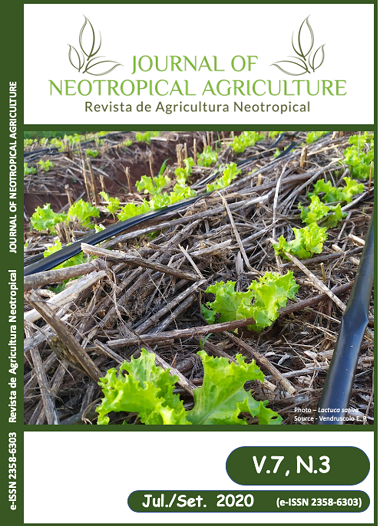INITIAL DEVELOPMENT OF COFFEE SEEDLINGS IN THE PRESENCE OF PLANT EXTRACTS
DOI:
https://doi.org/10.32404/rean.v7i3.4500Abstract
The coffee plant can grow together with different plants, but the presence of allelochemicals can affect the crop post-planting. This study aimed to evaluate the early growth of coffee seedlings following treatment with plant extracts from different botanical families. The experimental design used randomized blocks with four trials, in a 7 × 2 factorial scheme; the first factor consisted of aqueous extracts from six species: canola, crotalaria, brachiaria, sunflower, wheat, and lupine; water was used as the control. The second factor comprised of different botanical parts of the aforementioned six species of plant. The extracts were diluted to 5% concentration and were applied at a dose of 20 mL per plant. The agronomic variables analyzed were plant height (PH), stem diameter (SD), leaf area index (LAI), leaf dry matter (LDM), root dry matter (RDM), and root length (RL). Compared to the canola extract, the application of brachiaria extract resulted in the best response in PH, regardless of the botanical part that constituted the extract, leading to an increase in PH by 3.77 cm. The agronomic character most sensitive to the application of aqueous extracts was PH, in which the brachiaria extract was prominent in inducing the greatest growth, whereas the canola extract hindered the initial development of Arabica coffee seedlings.
References
(I) Barros, R.S., Maestri, M., 1974. Influence of climatic factors on growth periodicity of coffee (Coffea arabica L.). Revista Ceres, 21(1), 268-279.
(II) Bernat, W., Gawronska, H., Janowiak, F., Gawronski, S.W., 2004. The effect of sunflower allelopathycs on germination and seedling vigour of winter wheat and mustard. Zeszyty Problemowe Postepow Nauk Rolniczych, 496(1), 289-300.
(III) Borella, J., Pastorini, L.H., 2009. Allelopathic influence of Phytolacca dioica L. germination and early growth of Lycopersicum esculentum and Bidens pilosa. Biotemas, 22(3), 67-75.
(IV) Bortolini, M.F., Fortes, A.M.T., 2005. Efeitos alelopáticos sobre a germinação de sementes de soja (Glycine max L. Merrill). Semina: Ciências Agrárias, 26(1), 5-10.
(V) Corsato, J.M., Fortes, A.M.T., Santorum, M., Raquel Leszczynski, R., 2010. Allelopathic effect of sunflower water extract on the germination of soybean and hairy beggartick. Semina: Ciências Agrárias, 31(2), 353-360.
(VI) Costa, N.V., Rodrigues-Costa, A.C.P., Coelho, E.M.P., Ferreira, S.D., Barbosa, J.A., 2018. Methods of weed control in organic systems: a short review. Revista Brasileira de Herbicidas, 17(1), 25-44.
(VII) Freitas, C.D., Viecelli, C., 2011. Interference azevém alelopática in the germination and initial development of wheat plants. Cultivando o Saber, 4(3), 37-46.
(VIII) Kalburtji, K.L., 1999. Research on allelopathy in Greece, in: Narwal, S.S., (Eds.). Allelopathy Update. Enfield, Science Pub., p. 37-47.
(IX) Nunes, A.L., Trezzi, M.M., Debastiani, C., 2010. Integrated weed management in maize cultivation. Bragantia, 69(2), 299-304.
(X) Oerlemans, K., Barrett, D.M., Suades, C.B., Verkerk, R., Dekker, M., 2006. Thermal degradation of glucosinolates in red cabbage. Food Chemistry, 95(1), 19-29.
(XI) Oliveira, N.S., Mercadante, M.O., Lopes, P.S.N., Gomes, I.A.C., Pereira, E.G., Ribeiro, L.M., 2002. Efects of aqueous and ethanolic extracts. Unimontes Científica, 4(2), 1-12.
(XII) R Core Team, 2016. R: A Language and Environment for Statistical Computing. R Foundation for Statistical Computing, Vienna, Austria.
(XIII) Reigosa, M.J., Sánchez-Moreiras, A., Gonzáles, L., 1999. Ecophysiological approach in allelopathy. Critical Reviews in Plant Sciences, 18(5), 577-608.
(XIV) Rizzardi, A., Rizzardi, M.A., Lamb, T.D., Johann, L.B., 2008a. Allelopathic potential of aqueous extracts of canola genotypes on Bidens Pilosa. Planta Daninha, 26(4), 717-724.
(XV) Rizzardi, M.A., Neves, R., Lamb, T.D., Johann, L.B., 2008b. Allelopathic potential of canola crop (Brassica napus L. var. oleifera) on suppression of hairy beggar ticks (Bidens sp.) and soybean. Revista Brasileira de Agrociência, 14(2), 239-248.
(XVI) Roncatto, F., Viecelli, C.A., 2009. Green manure for sunflower on the development of maize. Cultivando o Saber, 2(3), 1-6.
(XVII) SBCS. Sociedade Brasileira de Ciência do Solo, 2017. Manual de Adubação e Calagem para o Estado do Paraná. Curitiba, SBCS/NEPAR.
(XVIII) Scognamiglio, M., Abrosca, B.D., Esposito, A., Fiorentino, A., 2015. Metabolomics: an unexplored tool for allelopathy studies. Journal of Allelochemical Interactions, 1(1), 9-23.
(XIX) Sera, T., Sera, G.H., 2013. IPR 107 - cultivar de café árabe anão com resistência à ferrugem do café. Crop Breeding and Applied Biotechnology, 13(3), 215-217.
(XX) Silva, E.A., Mata, F.M., Ducatti, C., Regazzi, O., Barros, R.S., 2004. Seasonal changes in vegetative growth and photosynthesis of Arabica coffee trees. Field Crops Research, 89(2-3), 349-357.
(XXI) Silva, J., Fortes, A.M.T., Gomes, F.M., Pinto, T.T., Bonamigo, T., Boiago, N.P., 2011. Allelopathy of Camelina sativa Boiss. (Brassicaceae) on germination and early development of Bidens pilosa (L.) and Glycine max (L.) Merr. Biotemas, 24(4), 14-24.
(XXII) Taiz, L., Zeiger, E., Moller, I.M., Murphy, A., 2017. Plant Physiology and Development, sixth ed. Sinauer Associates, Sunderland.
(XXIII) Tokura, L.K., Nóbrega, L.H.P., 2005. Cover crop allelopathic potential in the development of corn seedlings. Acta Scientiarum. Agronomy, 27(3), 287-292.
(XXIV) Tur, C.M., Borella, J., Pastorini, L.H., 2010. Allelopathic effects of aqueous extracts of Duranta repens on the germination and early growth of Lactuca sativa and Lycopersicum esculentum. Biotemas, 23(2), 13-22.
Downloads
Published
How to Cite
Issue
Section
License
The authors retain the rights to the manuscripts and, therefore, are free to share, copy, distribute, perform and publicly communicate the work under the following conditions:
Acknowledge work credits in the manner specified by the author or licensor (but not in a way that suggests that you have their support or that they support their use of their work).
REVISTA DE AGRICULTURA NEOTROPICAL (ISSN 2358-6303) is under license https://creativecommons.org/licenses/by/4.0/
The State University of Mato Grosso do Sul, Sustainable Development Center of Bolsão Sul-Mato-grossense (CEDESU), of the University Unit of Cassilândia (UUC), preserves the patrimonial rights (copyright) of the published works and favors and allows their reuse under the license as mentioned above.
------------
The journal reserves the right to make normative, orthographic, and grammatical alterations in the originals, to maintain the cult standard of the language, respecting, however, the style of the authors.
Final proofs will be sent to the authors.
Published works become the property of the journal. The opinions expressed by the authors of the manuscripts are their sole responsibility.

